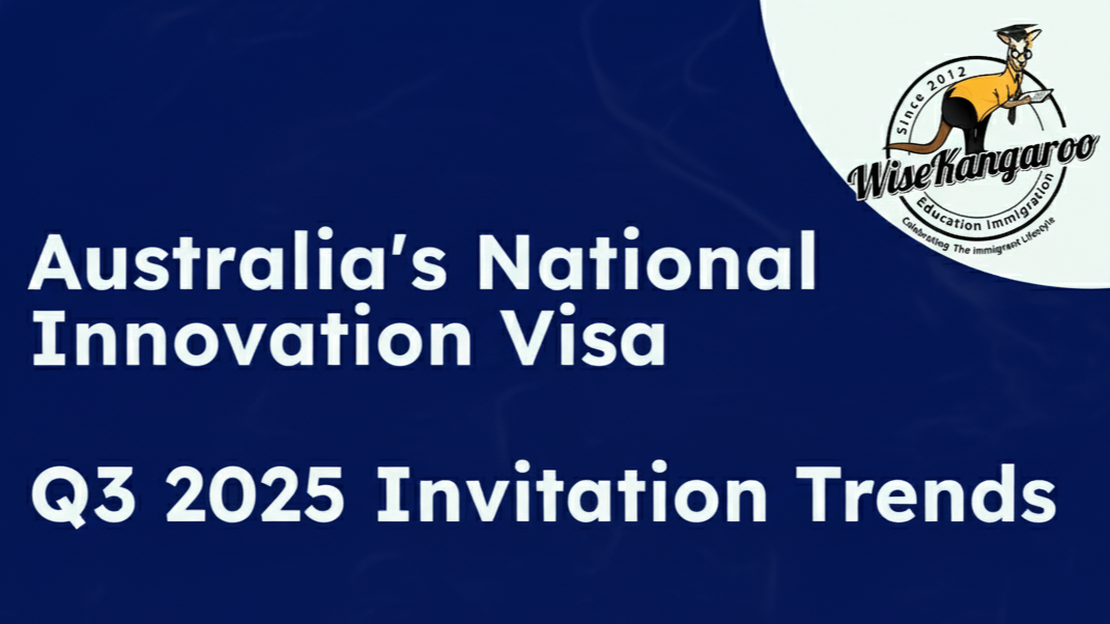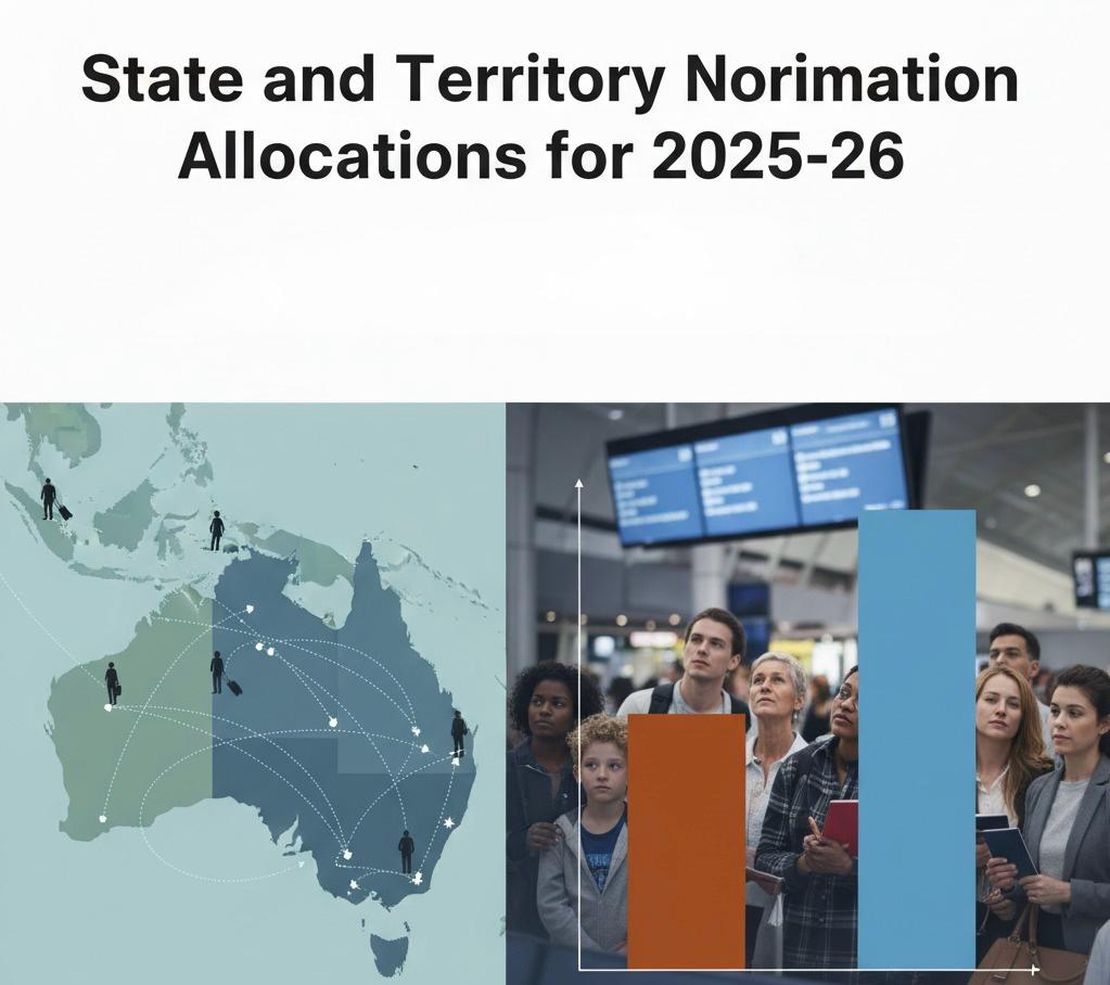Australia’s National Innovation Visa continues to gain momentum, with Q3 2025 marking the strongest quarter yet since the program’s launch. Between July and September 2025, the Department of Home Affairs issued 122 invitations from 1,841 Expressions of Interest, achieving a 6.6% invitation rate — up significantly from previous quarters.
For innovators, entrepreneurs, and researchers eyeing Australia’s premier permanent residency pathway, these numbers tell an important story about sector priorities, invitation patterns, and strategic positioning.
Let’s break down the data and what it means for prospective National Innovation Visa applicants.
Watch: National Innovation Visa Q3 2025 Invitation Trends
Q3 2025: The Strongest Quarter Yet
The third quarter of 2025 represents a significant milestone for the National Innovation Visa program. Here’s how the numbers stack up:
Q3 2025 at a Glance:
- EOIs Received: 1,841
- Invitations Issued: 122
- Invitation Rate: 6.6%
- Year-to-Date Invitations: 304 (across all three quarters)
What makes these numbers particularly interesting is the trend line. While total EOI submissions are decreasing, invitation rates are climbing sharply — indicating that the Department is becoming more selective and that higher-quality applications are coming through the pipeline.
Quarterly Comparison (2025 Year-to-Date)
| Quarter | EOIs Received | Invitations Issued | Invitation Rate |
|---|---|---|---|
| Q1 (Jan-Mar) | 3,299 | 70 | 2.1% |
| Q2 (Apr-Jun) | 2,856 | 112 | 3.9% |
| Q3 (Jul-Sep) | 1,841 | 122 | 6.6% |
The data shows a clear pattern: fewer applications, but more invitations being issued. This suggests the market is maturing, with applicants better understanding the high bar required for the NIV and submitting only when they meet the criteria.
Priority Breakdown: Where Invitations Are Going
The National Innovation Visa operates on a four-tier priority system, and the Q3 data shows exactly where the Department is focusing its attention.
Invitations by Priority Level (Q3 2025)
| Priority | Description | Q3 Invitations | Percentage |
|---|---|---|---|
| Priority 1 | Global “top of field” awardees | <5 | <4% |
| Priority 2 | Government-nominated experts | 17 | 14% |
| Priority 3 | Exceptional achievers in Tier 1 sectors | 84 | 69% |
| Priority 4 | Exceptional achievers in Tier 2 sectors | 20 | 16% |
Key Insight: Priority 3 candidates — exceptional achievers in Tier 1 sectors — continue to dominate the invitation landscape, accounting for approximately 7 in 10 invitations issued.
What This Means for Applicants
- Priority 1 & 2 candidates are invited as soon as they are identified by the Department
- Priority 3 & 4 candidates receive invitations during monthly invitation rounds
- Tier 1 sector alignment (Critical Technologies, Health Industries, Renewables) dramatically increases your invitation likelihood
- Government nominations (Priority 2) are an emerging strategic pathway worth exploring
If you’re targeting the NIV, understanding where you fit in this priority structure is critical to managing expectations and timing your application strategically.
Sector Analysis: Where Australia Wants Talent
The sector breakdown provides clear insight into Australia’s innovation priorities. Q3 2025 data shows that three sectors dominate the invitation landscape.
Invitations by Sector (Q3 2025)
Tier 1 Sectors (High Priority):
| Sector | Invitations | Share |
|---|---|---|
| Critical Technologies | 48 | 39% |
| Health Industries | 30 | 25% |
| Renewables & Low Emission Tech | 15 | 12% |
Tier 2 Sectors:
| Sector | Invitations |
|---|---|
| Defence, Space & Capabilities | 9 |
| Sports & the Arts | 8 |
| Agri-food, FinTech, Education, Transport | <5 each |
Critical Technologies and Health Industries together account for nearly two-thirds of all invitations issued in Q3 2025. If your expertise aligns with these sectors, your pathway to an invitation is significantly clearer.
What Qualifies as “Critical Technologies”?
Critical Technologies is a broad sector encompassing:
- Artificial Intelligence and Machine Learning
- Quantum Computing
- Advanced Manufacturing and Robotics
- Cybersecurity
- Blockchain and Distributed Ledger Technologies
- Advanced Materials and Nanotechnology
- Space Technologies
- Biotechnology
If you’re working at the cutting edge of any of these fields with demonstrable global recognition, the National Innovation Visa should be on your radar.
Strategic Insights: What the Data Tells Us
1. Quality Over Quantity
The decreasing EOI volume coupled with rising invitation rates suggests that prospective applicants are becoming more strategic. Gone are the days of “spray and pray” EOI submissions. The market is maturing, and applicants are self-selecting more effectively.
Takeaway: Don’t submit an EOI unless you genuinely meet the exceptional achiever criteria. The Department’s selection process is rigorous, and premature applications won’t improve your chances.
2. Tier 1 Sectors Are the Clear Winners
With 76% of Q3 invitations going to Tier 1 sectors (Critical Tech, Health, Renewables), sector alignment is arguably the single most important factor after demonstrating exceptional achievement.
Takeaway: If you’re on the borderline between sectors, strategic positioning within a Tier 1 sector could make the difference between an invitation and extended waiting.
3. Government Nominations Are Growing
Priority 2 (Government Nominations) accounted for 17 invitations in Q3 — a notable share. These nominations typically come from state/territory governments or Commonwealth agencies seeking specific expertise.
Takeaway: If you have a unique skillset that aligns with a specific government priority or project, exploring the government nomination pathway could be a strategic accelerator. Learn more about what makes a strong nominator.
4. EOI Management Matters
A critical policy note that many applicants miss: once an EOI is submitted, it cannot be edited or withdrawn. If your credentials improve (new publications, awards, funding, patents), you must submit a new EOI to reflect these achievements.
Takeaway: Keep your profile current. If you’ve achieved new milestones since submitting your EOI, don’t wait — submit a fresh EOI to maximize your chances in the next invitation round.
Comparing the NIV to Its Predecessor: Global Talent Visa
The National Innovation Visa replaced the Global Talent Visa program in December 2024. While both programs target exceptional talent, the NIV introduces more structure through its priority levels and explicit sector tiers.
Key Differences:
- More transparent priority system — applicants know where they stand
- Clearer sector targeting — explicit Tier 1 and Tier 2 classifications
- Monthly invitation rounds for Priority 3 & 4 (vs. rolling invitations under GTI)
- Same outcome — permanent residency (subclass 858) with full work rights
For former GTI applicants or those considering the transition, the NIV offers a more predictable (though still highly competitive) pathway to Australian permanent residency.
Success Stories: From EOI to Grant
At Wisekangaroo, we’ve guided multiple clients through successful NIV applications. Recent success stories include:
- A health researcher who received their grant in October 2025
- A health-tech entrepreneur who secured permanent residency just three days later
Both cases share common threads: exceptional global recognition, clear alignment with Tier 1 sectors, strategic positioning, and comprehensive documentation.
If you’re curious about what a winning NIV profile looks like, these case studies provide valuable insights into the level of achievement and preparation required.
Practical Steps for Prospective Applicants
Before You Submit an EOI
1. Honestly Assess Your Eligibility
The NIV bar is exceptionally high. You need demonstrable evidence of:
- Global recognition in your field (awards, publications, patents, media coverage)
- Significant achievements with measurable impact
- Alignment with one of Australia’s priority sectors
- Potential to contribute to Australia’s innovation ecosystem
If you’re not there yet, focus on building your credentials before submitting an EOI.
2. Document Your Achievements
Start compiling evidence now:
- Awards and recognition from peak bodies
- Citations and publication metrics
- Patents or intellectual property
- Media coverage and speaking engagements
- Letters of support from recognized experts
- Evidence of commercial success (funding, revenue, market traction)
3. Identify Your Target Sector
Be strategic about sector alignment. If your work spans multiple areas, position yourself in the Tier 1 sector that offers the strongest evidence base.
4. Secure a Qualified Nominator
The NIV requires a nominator who is a nationally recognized expert in your field. Finding the right nominator can take time, so start early. At Wisekangaroo, we maintain a network of qualified nominators across common sectors and can facilitate introductions for eligible clients.
After EOI Submission
1. Monitor Your Credentials
If you achieve new milestones post-submission (major award, significant publication, new patent), submit a fresh EOI. Remember: existing EOIs cannot be edited.
2. Track Invitation Rounds
The Department updates NIV statistics quarterly. Stay informed about invitation patterns, sector demand, and processing times to manage your expectations.
3. Prepare for the Full Application
If you receive an invitation, you’ll have 60 days to lodge your full visa application. Use this time wisely:
- Gather comprehensive supporting documents
- Prepare statutory declarations
- Organize evidence of global recognition
- Work with a registered migration agent to ensure completeness
Common Questions About NIV Invitations
How competitive is the National Innovation Visa?
The Q3 2025 invitation rate of 6.6% shows the NIV is highly selective. However, this rate has been climbing, suggesting that as applicants better understand the requirements, success rates are improving. For context, only 304 invitations were issued from nearly 8,000 EOIs submitted in 2025 year-to-date.
Can I increase my chances after submitting an EOI?
You cannot edit an existing EOI, but you can submit a new one if your credentials improve. Focus on achievements that demonstrate global recognition: major awards, significant publications, patents, substantial funding, or high-profile speaking engagements.
Which sector should I choose if my work spans multiple areas?
Choose the Tier 1 sector where you have the strongest evidence base. Critical Technologies, Health Industries, and Renewables & Low Emission Tech have the highest invitation rates, so if your work legitimately fits within one of these sectors, that’s your best strategic positioning.
What happens if I don’t receive an invitation?
EOIs remain active until you receive an invitation or withdraw them (by submitting a new one). There’s no “rejection” — your EOI simply remains in the pool. Continue building your credentials and consider submitting a new EOI when you achieve significant new milestones.
How long does the full visa process take after invitation?
From invitation to visa grant, timelines vary significantly based on application complexity and case officer workload. Recent successful cases we’ve handled have taken 4-8 months from invitation to grant, though some complex cases can take longer.
Why Work With Wisekangaroo for Your NIV Application
The National Innovation Visa is Australia’s most competitive migration pathway, and success requires more than just meeting the eligibility criteria. It requires strategic positioning, comprehensive evidence compilation, and expert guidance through a complex process.
At Wisekangaroo, we specialize in innovation pathway visas, including the NIV and its predecessor, the Global Talent Visa. Our services include:
- Honest eligibility assessment — we’ll tell you if you’re ready or what gaps to address
- Strategic sector positioning — maximizing your invitation likelihood through smart alignment
- Nominator matching — access to our network of qualified Australian experts across priority sectors
- Comprehensive EOI and application preparation — decision-ready submissions that anticipate case officer questions
- End-to-end support — guidance from initial assessment through to visa grant
We track NIV invitation trends, policy changes, and sector priorities continuously, giving our clients real-time strategic intelligence to inform their migration planning.
Ready to Explore Your NIV Pathway?
If you’re an exceptional innovator, entrepreneur, or researcher working in one of Australia’s priority sectors, the National Innovation Visa could be your pathway to permanent residency.
The Q3 2025 data shows that invitations are flowing to the right profiles — exceptional achievers with global recognition in high-priority sectors.
Book a strategy consultation today to assess your eligibility, identify gaps, and develop a winning NIV strategy.
For those exploring other skilled migration pathways, consider reviewing our guides on the Subclass 189 Skilled Independent visa and Subclass 190 Skilled Nominated visa.
Frequently Asked Questions
Q: What is the National Innovation Visa invitation rate?
A: In Q3 2025, the invitation rate was 6.6%, up from 3.9% in Q2 2025. This represents 122 invitations issued from 1,841 EOIs received. Year-to-date, 304 invitations have been issued from 7,996 EOIs (3.8% overall rate).
Q: Which sectors receive the most National Innovation Visa invitations?
A: Critical Technologies (48 invitations), Health Industries (30 invitations), and Renewables & Low Emission Tech (15 invitations) were the top three sectors in Q3 2025, collectively accounting for 76% of all Tier 1 invitations.
Q: Can I edit my National Innovation Visa EOI after submission?
A: No. Once an EOI is submitted, it cannot be edited or withdrawn. If your credentials improve or your circumstances change, you must submit a new EOI with updated information.
Q: How long does it take to receive a National Innovation Visa invitation?
A: Priority 1 & 2 candidates are invited as soon as they are identified. Priority 3 & 4 candidates are invited during monthly invitation rounds. Timelines vary based on your priority level, sector, and the strength of your profile.
Q: What happens after I receive a National Innovation Visa invitation?
A: After receiving an invitation, you have 60 days to lodge a complete visa application. This requires comprehensive documentation of your achievements, evidence of global recognition, health examinations, police certificates, and all supporting materials.
Q: Do I need an Australian nominator for the National Innovation Visa?
A: Yes, you need a qualified Australian nominator who is a nationally recognized expert in your field. The nominator must endorse your exceptional achievement and potential contribution to Australia. Migration agents like Wisekangaroo can help connect eligible applicants with appropriate nominators.
Q: What’s the difference between Priority 3 and Priority 4 in the NIV system?
A: Priority 3 candidates are exceptional achievers in Tier 1 sectors (Critical Technologies, Health Industries, Renewables & Low Emission Tech). Priority 4 candidates are exceptional achievers in Tier 2 sectors (Defence, Agri-food, FinTech, Education, Infrastructure, Resources, Sports & Arts). Priority 3 receives significantly more invitations due to higher government priority.
Last updated: October 2025. Information current as of publication date. Always check the official Department of Home Affairs website for the latest National Innovation Visa requirements and statistics.
This article is for general information only. For specific advice about your circumstances, consult a registered migration agent.





